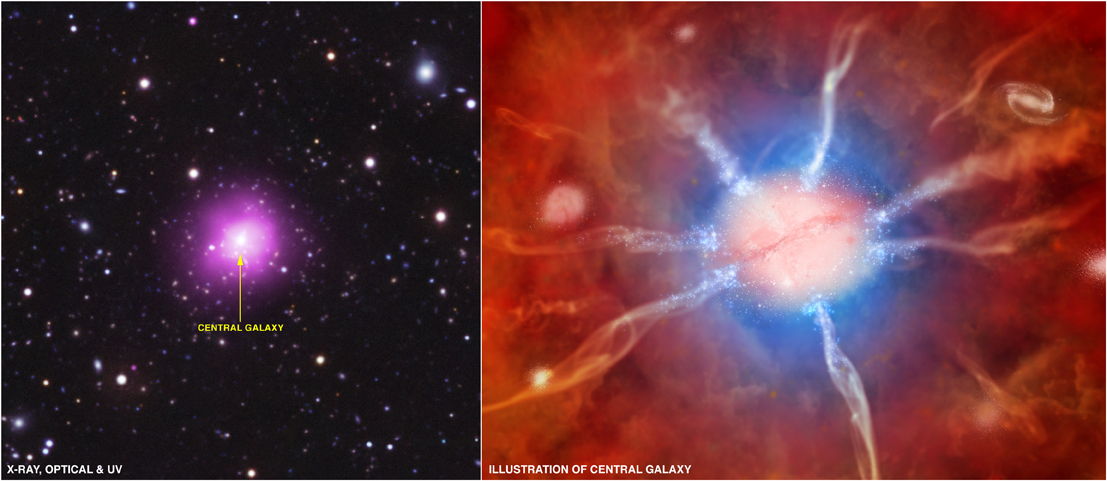
 Credit: X-ray: NASA/CXC/MIT/M.McDonald; UV: NASA/JPL-Caltech/M.McDonald; Optical: AURA/NOAO/CTIO/MIT/M.McDonald; Illustration: NASA/CXC/M.Weiss
Credit: X-ray: NASA/CXC/MIT/M.McDonald; UV: NASA/JPL-Caltech/M.McDonald; Optical: AURA/NOAO/CTIO/MIT/M.McDonald; Illustration: NASA/CXC/M.Weiss
The Star Factory
Giant clusters of galaxies are the among the largest gravitationally-bound structures in the Universe. The individual galaxies which compose the visible cluster tell only a minor part of the story, however. Galaxy clusters are mostly composed of dark matter, which is invisible to direct detection. Galaxy clusters also contain huge amounts of hot gas which is invisible to optical detection, but which generates copious amounts of emission in the X-ray band. The density of this hot gas increases near the gravitational center of the cluster, and can start to cool. Astronomers are not sure how this cooling proceeds, but in principle this dense gas can produce a "cooling flow" towards the cluster center, which can help feed, and drive the growth of, supermassive black holes. Especially dense regions in a cooling flow can even coagulate into stars, though in many cases strong jets from an actively feeding supermassive black hole can disrupt the flow and shut off star formation. The image on the left above is an X-ray (from Chandra), UV (from GALEX) and ground-based optical image (from the Blanco Telescope) of the Phoenix Cluster of galaxies. These observations of this cluster show a strong cooling flow which produces the most rapid rate of star formation ever observed in a galaxy cluster. The image on the right is an artist interpretation of what the flow onto the central galaxy of this cluster would look like if we could see it. Astronomers believe that the jets from the Phoenix cluster's central black hole are too weak to disrupt the flow, allowing for the high rate of star formation.
Published: August 20, 2012
<
HEA Dictionary ● Archive
● Search HEAPOW
● Other Languages
● HEAPOW on Facebook
● Download all Images
● Education ● HEAD
>

Each week the HEASARC
brings you new, exciting and beautiful images from X-ray and Gamma ray
astronomy. Check back each week and be sure to check out the HEAPOW archive!
Page Author: Dr. Michael F. Corcoran
Last modified Monday, 26-Feb-2024 17:36:12 EST


